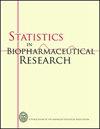超越Cox风险比:一种有针对性的学习方法在心血管结局试验中的生存分析
IF 1.5
4区 医学
Q3 MATHEMATICAL & COMPUTATIONAL BIOLOGY
引用次数: 0
摘要
摘要风险比(HR)是随机试验中一个公认的治疗效果指标,涉及事件发生时间的正确审查,自美国食品药品监督管理局2008年指导意见以来进行的心血管结果试验(CVOT)确实在很大程度上通过估计Cox HR来评估过度风险。另一方面,Cox模型和HR作为因果估计的局限性是众所周知的,美国食品药品监督管理局更新的2020年CVOT指南邀请我们重新评估这种默认的生存分析方法。我们强调了基于Cox HR的分析的缺点,并提出了一种遵循因果路线图的替代方案——从反事实因果问题到确定统计估计需求,最后到在大型统计模型中进行有针对性的估计。我们在模拟中展示了目标最大似然估计(TMLE)对信息审查和模型错误指定的稳健性,并展示了对利拉鲁肽在糖尿病中的作用和作用的原始Cox-HR分析的目标学习模拟:心血管结果评估(LEADER)试验。我们讨论了通过更新我们的生存方法,结合近几十年来在形式因果框架和有效非框架估计方面的进步,可以获得的潜在可靠性、可解释性和效率收益。本文章由计算机程序翻译,如有差异,请以英文原文为准。
Beyond the Cox Hazard Ratio: A Targeted Learning Approach to Survival Analysis in a Cardiovascular Outcome Trial Application
Abstract The Hazard Ratio (HR) is a well-established treatment effect measure in randomized trials involving right-censored time-to-events, and the Cardiovascular Outcome Trials (CVOTs) conducted since the FDA’s 2008 guidance have indeed largely evaluated excess risk by estimating a Cox HR. On the other hand, the limitations of the Cox model and of the HR as a causal estimand are well known, and the FDA’s updated 2020 CVOT guidance invites us to reassess this default approach to survival analyses. We highlight the shortcomings of Cox HR-based analyses and present an alternative following the causal roadmap—moving in a principled way from a counterfactual causal question to identifying a statistical estimand, and finally to targeted estimation in a large statistical model. We show in simulations the robustness of Targeted Maximum Likelihood Estimation (TMLE) to informative censoring and model misspecification and demonstrate a targeted learning analogue of the original Cox HR-based analysis of the Liraglutide Effect and Action in Diabetes: Evaluation of Cardiovascular Outcome Results (LEADER) trial. We discuss the potential reliability, interpretability, and efficiency gains to be had by updating our survival methods to incorporate the recent decades of advancements in formal causal frameworks and efficient nonparametricestimation.
求助全文
通过发布文献求助,成功后即可免费获取论文全文。
去求助
来源期刊

Statistics in Biopharmaceutical Research
MATHEMATICAL & COMPUTATIONAL BIOLOGY-STATISTICS & PROBABILITY
CiteScore
3.90
自引率
16.70%
发文量
56
期刊介绍:
Statistics in Biopharmaceutical Research ( SBR), publishes articles that focus on the needs of researchers and applied statisticians in biopharmaceutical industries; academic biostatisticians from schools of medicine, veterinary medicine, public health, and pharmacy; statisticians and quantitative analysts working in regulatory agencies (e.g., U.S. Food and Drug Administration and its counterpart in other countries); statisticians with an interest in adopting methodology presented in this journal to their own fields; and nonstatisticians with an interest in applying statistical methods to biopharmaceutical problems.
Statistics in Biopharmaceutical Research accepts papers that discuss appropriate statistical methodology and information regarding the use of statistics in all phases of research, development, and practice in the pharmaceutical, biopharmaceutical, device, and diagnostics industries. Articles should focus on the development of novel statistical methods, novel applications of current methods, or the innovative application of statistical principles that can be used by statistical practitioners in these disciplines. Areas of application may include statistical methods for drug discovery, including papers that address issues of multiplicity, sequential trials, adaptive designs, etc.; preclinical and clinical studies; genomics and proteomics; bioassay; biomarkers and surrogate markers; models and analyses of drug history, including pharmacoeconomics, product life cycle, detection of adverse events in clinical studies, and postmarketing risk assessment; regulatory guidelines, including issues of standardization of terminology (e.g., CDISC), tolerance and specification limits related to pharmaceutical practice, and novel methods of drug approval; and detection of adverse events in clinical and toxicological studies. Tutorial articles also are welcome. Articles should include demonstrable evidence of the usefulness of this methodology (presumably by means of an application).
The Editorial Board of SBR intends to ensure that the journal continually provides important, useful, and timely information. To accomplish this, the board strives to attract outstanding articles by seeing that each submission receives a careful, thorough, and prompt review.
Authors can choose to publish gold open access in this journal.
 求助内容:
求助内容: 应助结果提醒方式:
应助结果提醒方式:


